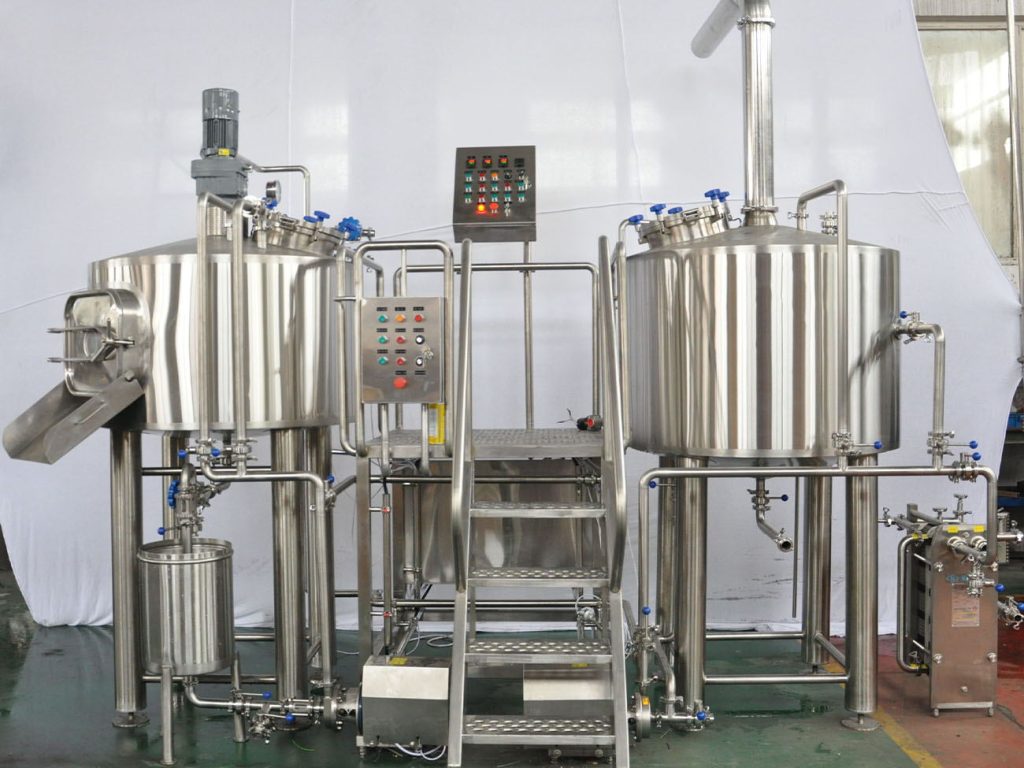A 3BBL (Barrel) electric brewing system is a brewing setup designed for producing small-batch craft beer with an electric heating source.A 3BBL electric brewig system is well-suited for craft brewers looking to produce high-quality beer with precise control and efficiency.

We recommend electrical heating for brewhouses up to 840L/7BBL as above this size you start drawing serious power. It would be better to consider other options.
3bbl electric brewing system
Description
3BBL Mash/Lauter tun
3BBL Mash/Lauter tun is a vessel used in the mashing process to convert the starches in crushed grains into sugars for fermentation. mash/lauter tuns are insulated to maintain a constant temperature. The mash/lauter tun have a false bottom and spigot so that the sparging process can be done in the same vessel. Steam jacket design will allow the systems are designed to do both decoction mashing and infusion mashing. The mashing tun/kettle is made out of stainless steel or copper.
It has the same capacity as the cooking tun and can also be made out of stainless steel or copper cladding. It has a design with a false bottom in stainless steel v-wire and a raking gear that has the function of an agitator, a rake and a spent gain remover. This is a very unique and helpful tool because after filtering the spent grains will be removed from the lauter tun, saving a lot of time and energy of the brewmaster.
3BBL Boiling Kettle/Whirlpool tun
After lautering, the beer wort is boiled with hops (and other flavorings if used) in a tank known as a kettle/whirlpool tun. The boiling process is where chemical and technical reactions take place, including sterilization of the wort to remove unwanted bacteria, releasing of hop flavors, bitterness and aroma compounds through isomerization, stopping of enzymatic processes, precipitation of proteins, and concentration of the wort.
At the end of the boil, the hopped wort settles to clarify in the same vessel, there is a tangential inlet of wort on the vessel. Thus, a vortex is formed when the wort is infused along the arc inside surface, so that the more solid particles in the wort are separated out. Whirlpool can happen in the kettle because there is no obstacle inside the kettle.
2 Vessels 3BBL Brewhouse
3BBL Mash/Lauter Tun + 3BBL Boil Kettle/Whirlpool Tun
3BBL Mash/Lauter Tun/Hot Liquor Tank Combined vessel + 3BBL Boil Kettle/Whirlpool Tun
3BBL Mash/Lauter Tun + 3BBL Boil Kettle/Whirlpool + 6BBL Hot Liquor Tank
Configuration:
A 3-barrel (3BBL) electric brewing system, relying on electricity for heating and powering the brewing process, typically consists of the following configuration:
Mash/Lauter Tun:
This vessel combines mashing (converting grain starches into fermentable sugars) and lautering (separating the liquid wort from the spent grains).
Brew Kettle/Whirlpool:
Functions as the vessel for boiling the wort and performing whirlpooling.
Contains an electric heating element to achieve and maintain boiling temperatures.
Often includes a separate whirlpooling section to settle solids post-boil.
Hot Liquor Tank (HLT):
Stores and heats water used in various brewing stages like mashing, sparging, and cleaning.
Equipped with electric heating elements to heat water to required temperatures.
Control Panel:
Manages and regulates the electric heating elements, pumps, and other components.
Includes temperature controllers, timers, and safety features to ensure precise and safe operation.
Heat Exchanger:
Cools down the hot wort rapidly by exchanging heat with cold water, bringing it to fermentation temperatures.
Ensures rapid cooling to prevent off-flavors and promote proper yeast fermentation.
3BBL Fermentation Tanks:
Receive the cooled wort for fermentation, converting sugars into alcohol and other compounds.
Vary in size and often equipped with temperature control systems to maintain ideal fermentation conditions.
CIP Cleaning System:
Equipment for cleaning and sanitizing brewing vessels and piping between batches to maintain hygiene and beer quality.
This 3bbl electric brewing system setup provides the essential components necessary to conduct brewing operations, relying on electric heating elements for temperature control and power throughout the brewing process. The system’s design allows for efficient brewing and precise control over temperatures critical for producing high-quality beer.